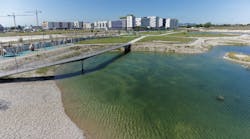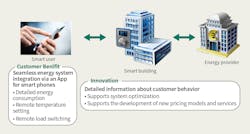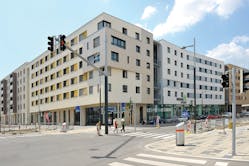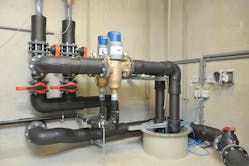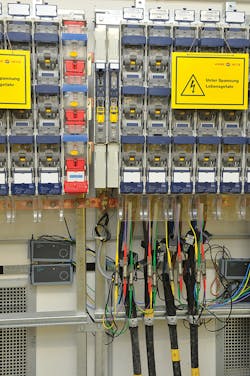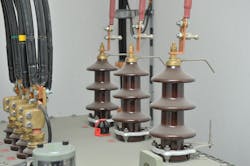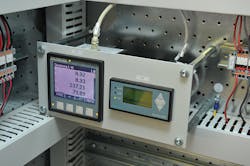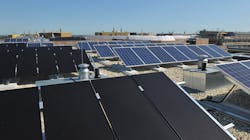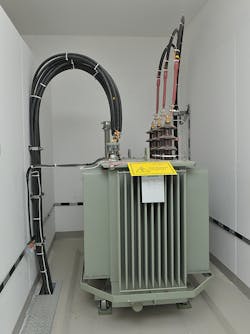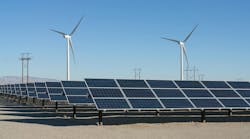Austria’s capital city of Vienna is creating a new district in which the buildings, electrical grid and energy market will be monitored continuously in a world-class living laboratory that incorporates new distribution grid solutions and energy-saving technologies. The Aspern Urban Lakeside project is being developed on the site of a former airport that has an area of 2.4 sq km (0.927 sq miles) some 25 minutes by subway from downtown Vienna. This long-term project will include 10,500 residential apartments, offices, shops, training establishments and industry, ultimately creating 20,000 job opportunities. With an investment totaling €5.5 billion (US$6.06 billion), the construction period will continue until 2028.
Reduction of carbon dioxide emissions and per-capita energy consumption as well as ensuring a failure-free supply of energy are the fundamental goals of the energy transition, which is characterized by increasingly decentralized energy generation, prosumers and new storage technologies. The research project is managed by Aspern Smart City Research GmbH & Co. KG (ASCR), a joint venture formed in 2013 among distribution system operator Wiener Netze GmbH, Vienna’s electricity, gas and district heating network operator; energy service provider Wien Energie GmbH, Vienna’s energy supplier; technology company Siemens AG; and the City of Vienna.
This cooperative partnership was established to develop some of the technical solutions required for the future energy environment, especially in a new real-life urban district with active consumers. This involves innovative approaches to building automation systems and using the energy flexibilities of buildings and the energy market in ways that enable residents to cooperate and accept the new systems. Furthermore, optimal methods are being developed to capture detailed network-status data for use in network planning. All these solutions are based on comprehensive information and communications technology (ICT) as well as testing and developing convenient big-data models and suitable analytics.
Smart Buildings
ASCR is implementing one of the most innovative and sustainable energy-efficiency showcase projects in Europe. Real data is used for research on complex correlations as well as integrated elements and components. Based on national and international experience, ASCR is exploring not only individual aspects in the Aspern Urban Lakeside but also the entire system. Buildings, the electricity grid, communications and information technologies, and user behavior all are captured in the large-scale energy research program.
The smart building research objectives of ASCR include three building types:
1. Residential building with 213 apartments, seven heat pumps (800 kW), hybrid panels for solar-thermal generation (65 kW) and power generation (16 kW), photovoltaics (20 kW), electric heating cartridges (4 kW hot water), geothermal heat (60 kW) and hot water accumulators, a battery (2 kWh) and apartment automation.
2. Student home for 300 students with photovoltaics (220 kW), a battery (120 kWh) and electric heating cartridges (two quantity of 8 kW hot water).
3. School campus comprising kindergarten and primary school equipped with two heat pumps (510 kW), photovoltaics (29 kW), solar-thermal generation (90 kW) and electrical cartridges (two quantity of 35 kW).
Complex ICT systems facilitate the optimal management of generation, distribution, consumption, storage and transmission of energy. Two buildings equipped with conventional technology will be used as benchmarks for the research project.
One of the priority areas for ASCR is optimizing a building’s own use of energy, as current building optimization systems cannot predict the future. However, this is about to change as intelligent building management systems focus on calculating estimated energy requirements with due consideration given to weather forecasts and other data. Additionally, they can provide information about the condition of individual building units and, thus, support the forward planning of maintenance.
In addition to optimizing energy consumption, the research company is primarily interested in the potential of buildings to make energy flexibility available outside their walls. Consequently, one of the most important questions is how buildings can use their flexibility in the future to support local medium- and low-voltage networks or, alternatively, participate as an active player in the electricity market.
To master these challenges, aggregation levels must be created within a few buildings and, in the future, even with up to several thousand buildings. At least two systems are used for this purpose. One is a building energy management system (BEMS), which is in the building itself and calculates the electricity consumption of the building and any flexibility at regular intervals. The other is the energy pool manager (in our case Decentralized Energy Management - DEMS) that acts as an interface between the individual building and the electricity market.
To participate in balancing energy markets, intelligent electricity networks are required to determine and forecast the network status at all times.
Smart Grid
The ASCR smart grid consists of 20/0.4-kV secondary substations equipped with 24 transformers. Transformers with different technologies are being used, including amorphous core, ester midel, aluminum and on-load tap changers as well as five grid storage systems. Many sensors—including grid monitoring devices and smart meters in three building blocks, designed to deliver consumption and grid data to the low-voltage grid control center—constitute the basic infrastructure of the ASCR smart grid test bed.
The approach adopted here is based on the optimal use of existing copper reserves and integrated smart ancillary technologies continuously along the smart grid migration path. This serves as a guideline for the transition from a passive distribution network to a smart grid, with its bidirectional load and communication flows. This can be thought of as a smart grid migration path:
• The status of the electricity network, that is the usage down to the low-voltage level, must be transparent. The low-voltage networks constitute the largest part of the electricity network and are the most active areas in terms of grid dynamics and fluctuating voltages. Data collection is recorded by smart meters and self-configuration field sensors, including power-quality measuring devices or grid monitoring devices. This is all part of the grid monitoring aspect of the project.
• Smart meters already have been tested, but they only provide rough data. Additional measurements and sensors increase the project costs, but they also provide a more accurate overview of the network status. A core objective of the ASCR research program is to determine the minimum required coverage with sensors to provide a sufficiently detailed picture of the network status for optimal network operation and network planning, with due consideration given to economic efficiency.
• For planning and low-voltage management further down the smart grid migration path, the data can be used to make management decisions that do not require any physical network expansion. They represent an efficient alternative to vague worst-case planning. Without active network intervention, specific network data enables the infrastructure to be operated closer to its physical limits, providing early warnings when thresholds or established key performance indicators (KPIs) are threatened to be exceeded.
• Active grid intervention can help to increase the efficiency of electricity network infrastructure. However, this requires all components to be as fault-tolerant as possible. Furthermore, they should not generate any significant additional costs during the rollout or in operation. This can be ensured by means of system solutions with component-support functions such as zero touch, plug and play, and plug and automate.
Smart User
Users represent a particularly important part of the ASCR research activities, because it ultimately depends on how much energy the building requires and to what extent it can offer flexibilities. However, the research program only includes apartment residents (50%) who have given written approval permitting their energy consumption and ambient air control system (electricity, heat, hot and cold water, room temperature and room air quality) usage data to be used for research purposes. The aim is to find out how the buildings, occupied by a diverse population, can work in an optimal way. This requires information on current use habits and future needs. Consequently, the cooperation with users was supported continuously by social scientists.
As a basis for home automation, smart measuring and control technology (smart MCT) is installed in participating households to control the air quality and temperature of the residence to optimize the building energy consumption. Residents can intervene with the smart MCT and change the air-quality and temperature levels themselves, even remotely from a tablet or smartphone. Additionally, they can test innovative products and services to control their individual energy consumption (for example, time-variable tariff models), which in turn helps the research team to develop innovations.
However, the aim is to promote sustainable cost- and energy-efficient usage by means of incentives and raising awareness. The paradigm of today is this: Generation follows consumption, meaning the generation is adapted to the consumption. In the future, it must be possible to adapt consumption more toward fluctuating renewable energy generation.
Smart ICT
With due consideration given to data protection guidelines, smart ICT uses all data obtained from the buildings and network (temperature, room air quality, electricity consumption, voltage, etc.) as well as external data (for example, weather or other related events) to analyze the interaction and interdependencies between the network and buildings. The essential factor is the integrated view of data from various domains.
Using real data from the test field, the ASCR research team creates a digital twin of reality to simulate any energy concepts as well as optimization measures. The objective here is to develop scalable and feasible solutions for urban energy balance. Because building occupancy and network capacity utilization constantly changes, the models on which the simulations run must be adjusted on a continuous basis. The models, and thus the internal building and network control mechanisms, are refined by means of adaptive self-learning algorithms.
Big-data methods are used to cope with the enormous data volumes from the various domains. Numerous different data models can be used depending on the area of application. As a part of the ASCR research program, both large centralized and decentralized data models in the style of the Hadoop software framework are tested. Some of the data analytics scenarios are as follows:
• Low-voltage grid anomaly detection — In this scenario, a huge volume of fine-grained grid measurements (voltage, power, etc.) are analyzed to detect outliers and unusual patterns. The goal is to identify the relevant grid segments and time frames for further investigation, simulation and planning. This descriptive analytics task, basically retrieved from the grid operator, only considers aggregated data from many individuals. Consequently, only the building operators (as legal entities) need to agree on the usage of the total building energy measurements.
• Identification of building energy patterns — This scenario focuses on the analysis of building performance data, which includes time series from heterogeneous measurement devices (power, heating, water, ventilation, etc.). The purpose of this diagnostic analytics task is classification and comparison of energy profiles for entire buildings or building parts. The valuable derived information can be used for energy consumption planning or pricing. Also, data from individuals can be used if consent has been granted, but generally only overall building data is used. Consequently, only the building operators are required to provide permission for the data dissemination.
• Building prognosis — A potential succeeding task of the identification of building energy patterns is the prognosis of the future behavior of buildings or building parts. This predictive analytics task uses historical information and the derived patterns to estimate an energy schedule for the near future. This offers crucial information that can be used to develop a more flexible energy market or to stabilize the grid, if necessary. From a data perspective, mainly building data and derived data is being used. In addition, external factors like weather are considered for the estimation of solar power generation or consumption.
• Grid prognosis — The improved prognosis of the state and demand of the low-voltage grid in the near future is a challenging predictive task with large financial potential for the grid operators when it comes to balancing unscheduled power flows. The grid prognosis is based on historical measurements from the grid and external data such as weather or mass events. Similar to the first scenario, the data analyzed is retrieved from the grid operator and only consent from the building operators is required.
• Data availability for future applications — One of the goals of the project is to enable new business opportunities based on cross domain and cross vendor integration of data. This integration builds the foundation for new smart applications, where new revenues can be generated through data collected in the city. Clearly, all applications and business models must respect users’ privacy, which imposes several challenges for data governance and monitoring.
Observations to Date
The first data analytics already provide some illuminating results on asymmetric loads and the detection of faulty installation. The ASCR also has observed, in residential areas, certain unbalanced building loading of the three-phase distribution network. This is a result of the consumer’s white goods and television sets, all of which have been connected to the same phase to minimize the cost of internal wiring installation.
Also, as a result of analysing all available data, ASCR has been able to detect current sensors that have been installed incorrectly. These analytics offer an opportunity to check for this more quickly in future installations to avoid repetition.
ASCR has just started analysing all the available data, but the initial results underline the decision taken by the three partners, Wien Energie, Wiener Netze and Siemens, to cooperate in the form of a joint venture in Vienna.
Wiener Netze
Wiener Netze GmbH is a subsidiary of Wiener Stadtwerke Holding AG (Vienna Municipal Utilities) and is Austria’s largest distribution system operator for supplying electricity, gas and district heating to 1.2 million customers. To be able to safeguard a high degree of supply reliability and quality of supply, the utility has embarked on a programme of high capital investment in the infrastructure. The electrical power mission of Wiener Netze is responsible for customer services, network strategy and planning as well as construction, operation and maintenance of the gas, primary district heating and electricity grid. Furthermore, Wiener Netze is responsible for meter management, data and regulatory management.
Wien Energie
Wien Energie GmbH is a subsidiary of Wiener Stadtwerke Holding AG (Vienna Municipal Utilities) and is responsible for ensuring the reliable supply of electricity, natural gas and heating to a population of some 2 million customers, 230,000 businesses and industrial facilities as well as 4500 farms in the greater Vienna metropolitan area. The utility also is responsible for waste recycling, providing energy–related advice and services, facility management and telecommunications. Moreover, Wien Energie is active in a number of projects at a European level.
Wien Energie offers heating, cooling and decentralized products directly, such as citizen investment models. Electricity and gas are sold by a subsidiary, Wien Energie Vertrieb GmbH & Co.KG.
With an annual turnover of €1,820.8 million ($US 2,041 million) in 2015, Wien Energie is among Austria’s top 30 companies in terms of turnover. In the 2015 Business Report, employees totaled 2680, making Wien Energie Group one of the largest employers in the Austrian capital.
Acknowledgement
The authors wish to express their thanks for the technical support and assistance given by staff at Siemens in the preparation of this article.
